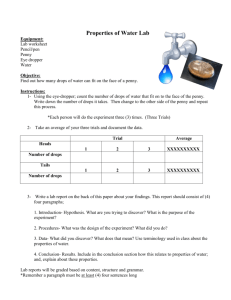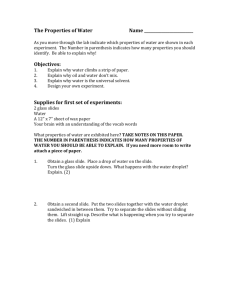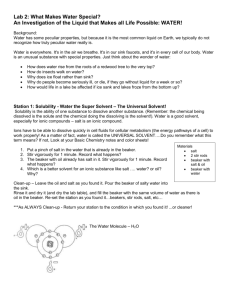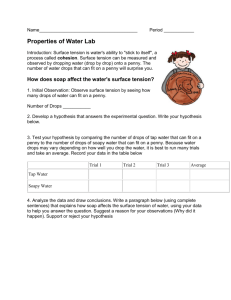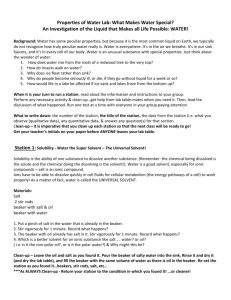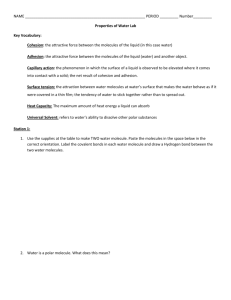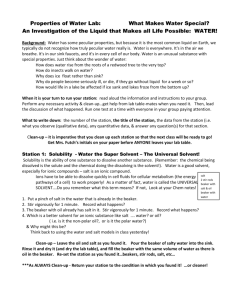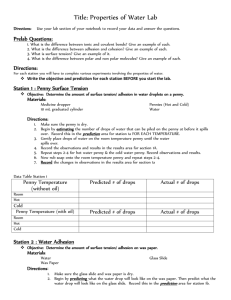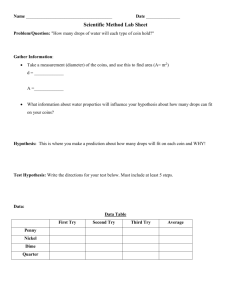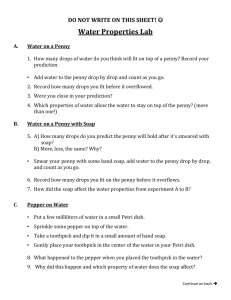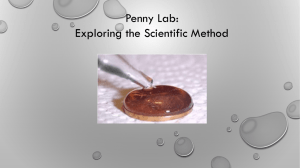Water properties Activity
advertisement
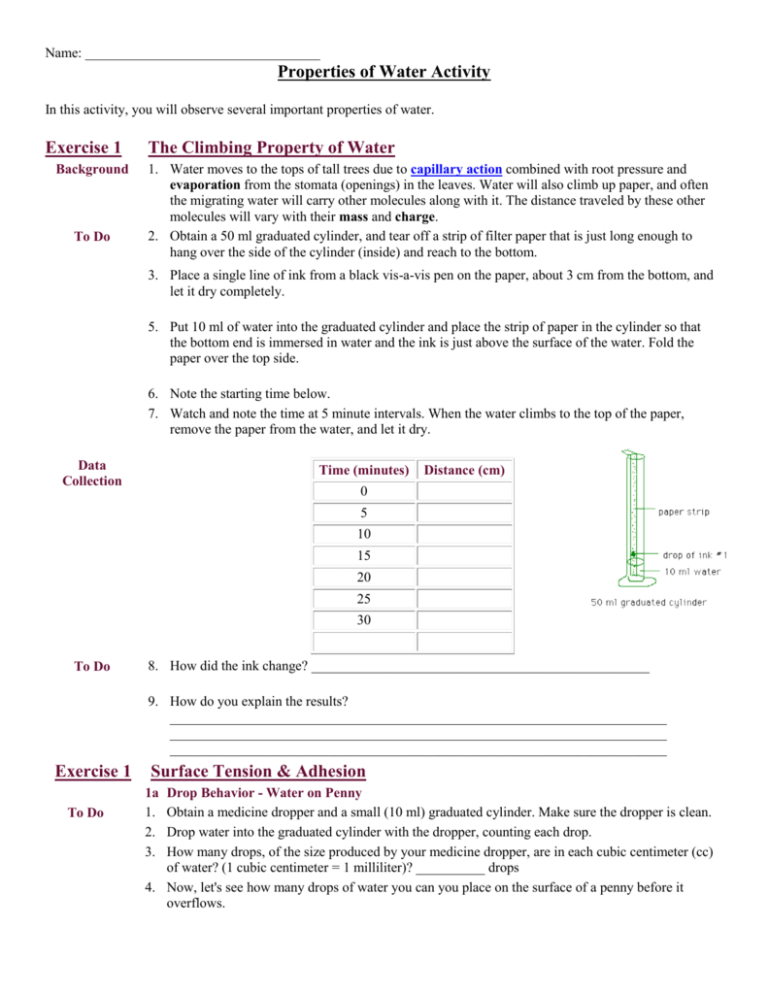
Name: __________________________________ Properties of Water Activity In this activity, you will observe several important properties of water. Exercise 1 Background To Do The Climbing Property of Water 1. Water moves to the tops of tall trees due to capillary action combined with root pressure and evaporation from the stomata (openings) in the leaves. Water will also climb up paper, and often the migrating water will carry other molecules along with it. The distance traveled by these other molecules will vary with their mass and charge. 2. Obtain a 50 ml graduated cylinder, and tear off a strip of filter paper that is just long enough to hang over the side of the cylinder (inside) and reach to the bottom. 3. Place a single line of ink from a black vis-a-vis pen on the paper, about 3 cm from the bottom, and let it dry completely. 5. Put 10 ml of water into the graduated cylinder and place the strip of paper in the cylinder so that the bottom end is immersed in water and the ink is just above the surface of the water. Fold the paper over the top side. 6. Note the starting time below. 7. Watch and note the time at 5 minute intervals. When the water climbs to the top of the paper, remove the paper from the water, and let it dry. Data Collection Time (minutes) Distance (cm) 0 5 10 15 20 25 30 To Do 8. How did the ink change? _________________________________________________ 9. How do you explain the results? ________________________________________________________________________ ________________________________________________________________________ ________________________________________________________________________ Exercise 1 To Do Surface Tension & Adhesion 1a 1. 2. 3. Drop Behavior - Water on Penny Obtain a medicine dropper and a small (10 ml) graduated cylinder. Make sure the dropper is clean. Drop water into the graduated cylinder with the dropper, counting each drop. How many drops, of the size produced by your medicine dropper, are in each cubic centimeter (cc) of water? (1 cubic centimeter = 1 milliliter)? __________ drops 4. Now, let's see how many drops of water you can you place on the surface of a penny before it overflows. Data Collection To Do 5. How many drops do you predict? person #1 person #2 person #3 6. Drop water from the dropper onto a penny, keeping careful count of each drop. Draw a diagram below showing the shape of the water on the penny after one drop, when the penny is about half full, and just before it overflows. Data Collection Results To Do Predict 7. How many drops were you able to place on the surface of the penny before it overflowed? __________ drops 8. Cohesion is a property where molecules of the same substance stick together. Explain how this is demonstrated with the drops of water on the penny. ________________________________________________________________________ ________________________________________________________________________ 1b Effects of Detergent 1. With your finger, spread one small drop of detergent on the surface of a dry penny. 2. How many drops do you think this penny will hold after being smeared with detergent, more, less, or the same as before? Why? _______________________________________________________________________ To Do 3. Using the same dropper as before, add drops of water to the penny surface. Keep careful count of the number of drops, and draw the water on the penny after one drop, about half full, and just before overflowing. Results 5. How many drops were you able to place on the penny before it overflowed this time? __________ drops Question 6. Did the detergent make a difference? Describe the effect of the detergent. ________________________________________________________________________ Interpret 7. What does the detergent do to the cohesive property of water? How does this make detergents good cleaning agents? ________________________________________________________________________ ________________________________________________________________________ Question 1c Drop Shape on Glass and Wax Paper 1. What will be the shape of a drop of water on (a) a piece of wax paper and (b) a glass slide. Draw the shape of the drop you expect on each surface: __________ wax paper To Do Interpret __________ glass 3. Perform the experiment. Place several drops of water on each surface and draw the results below. __________ wax paper __________ glass 4. Compare your predictions with your observations and explain. _______________________________________________________________________________ _______________________________________________________________________________ 5. Can you explain the differences in drop behavior in terms of adhesion - that is, the formation (or absence) of hydrogen bonds between molecules of different types? Which molecules? _______________________________________________________________________________ _______________________________________________________________________________ Exercise 3 To Do Predict To Do Results Question Interpret 1. Place 8 ml of cooking oil in a 10 ml graduated cylinder. 2. What will happen when you add water? (Predict by choosing a, b, c, d, or e below) a. the water will float on top of the oil b. the water will sink to the bottom of the oil c. the water will dissolve in the oil d. the water will become mixed up with the oil 3. Gently add 2 ml of water by tilting the cylinder of oil slightly and letting the water run slowly down the inside of the cylinder. What happened? ________________________________________________________________________ _______________________________________________________________________________ ________________________________________________________________ Oil is a hydrophobic or 'water hating' molecule, so called because its chemical structure does not allow the formation of hydrogen bonds. Therefore, oil does not dissolve in water. When mixed, the two substances form separate layers, and because oil is less dense, it sits on top of water. 4. Which is less dense (that is that has less weight per ml.), oil or water? ____________________ 5. This characteristic behavior of water and oil is of critical importance for living things, determining many properties of the cell. Can you explain how? Lipids are very similar to oils. Consider the picture that follows: Figure 10. Enlargement of Cell Membrane to Show Phospholipid Bilayer. ____________________________________________________________________________________ ____________________________________________________________________________________ ____________________________________________________________________________________
